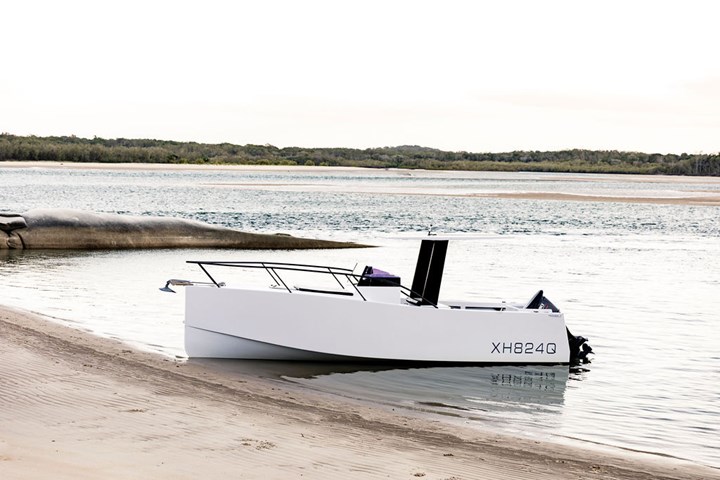ATL Composite panel systems enable Noosa 7 dynamic dayboat design
The Noosa 7 is hand-built and customized using DuraKore and DuFlex composite panel systems, minimizing material waste, tooling costs and simplifying quotations.

All photo credit: Noosa Marine
The team at Noosa Marine (Noosa, Australia) has announced that it is crafting the Noosa 7, a seven-meter motor yacht designed by Director Julian Griffiths and said to be only the second unit ever built. The dayboat is constructed using DuraKore and DuFlex panel systems from ATL Composites (Molendinar, Australia) and at 2.3 meters wide x 7.3 meter long, weighs only 1,250 kilograms.
With space for up to eight people, sleeping four in comfort, the Noosa 7 boasts a deck shower and fridge under the helm, and a 140-horsepower Suzuki engine. It is also lightweight enough that it can be transported via trailer.
Noosa Marine’s Julian Griffiths is said to be renowned for his expertise in building multihulls for marine craft using these composite panel systems, including the Schionning G Force 2000 Special (“KATO”) catamaran, as well as the Roger Hill-designed 14-meter AYANA and 19.5-meter BAJACA. Noosa Marine says Griffiths is now focused on promoting his own designs under the Noosa brand.
The Noosa 7 was one such design, and was first built ten years ago. “It was ahead of the times,” Griffith says. The craft is said to be compact, light weight, serves well as a day boat or weekender and is sturdy and stable enough for runs up to Double Island Point and Musgrave Island from Noosa at a top speed of 30 knots. “I built the first one for myself, without plans, just making it up as we went along. For this second one, we’re making plans as we go. A draughtsman is measuring and doing the drawings which will be computerized. Then we’ll get a kit produced from ATL so future boats are a quicker build for us.”
The first Noosa 7 was constructed using DuraKore Strip Planking for the hull, but Griffith says the following models will be made of 100% DuFLEX Composite Panels in CNC-routed kit form. The kit technology minimizes material waste, tooling costs and simplifies quotations.
“DuFLEX is brilliant to work with,” says Griffith. “You can create boats that are quicker, lighter and stronger. Our boats aren’t molded. Instead, they are made by hand, using widely spaced temporary build frames that are CNC- routed from design files to the required shape. Large parts like hull panels are created by bending the flat panels around the frames, ensuring a fair hull shape.”

Build time is approximately four months and the cost of the Noosa 7 with engine and nav gear is approximately $140,000. “This is a hand-built, high-end, epoxy composite product. Unique and one-off, you are buying a custom vessel. It’s not for everybody, but we are hopeful of catering to a niche of coastal cruisers looking for something different,” says Griffith. He adds that Noosa Marine is aiming to build around five to eight per year, depending on labor.
“There’s also a 10-meter version in the works, just waiting for somebody to spot it and make it their own,” he says. The larger model will be priced around $300,000. “It’s more like a super tender, European style with a V8 diesel inboard and the works onboard.”
Owners will also be provided after-sales support. “It’s my name, my pride that go into our boats,” asserts Griffith. “Once you buy one of our boats, you’re in the family.”
Related Content
JEC World 2022, Part 3: Emphasizing emerging markets, thermoplastics and carbon fiber
CW editor-in-chief Jeff Sloan identifies companies exhibiting at JEC World 2022 that are advancing both materials and technologies for the growing AAM, hydrogen, automotive and sustainability markets.
Read MoreCFRTP enables better, greener smartphones
Carbon Mobile’s “monocoque” design eliminates separate case, cover and frame, better protects electronics and simplifies disassembly.
Read MoreThermoset-thermoplastic joining, natural fibers enable sustainability-focused brake cover
Award-winning motorcycle brake disc cover showcases potential for KTM Technologies’ Conexus joining technology and flax fiber composites.
Read MorePlant tour: National Institute for Aviation Research, Wichita, Kan., U.S.
NIAR, located at Wichita State University in the heart of the American aerospace manufacturing industry, has evolved to become a premier hub of teaching, R&D, creativity and innovation.
Read MoreRead Next
Composites end markets: Energy (2024)
Composites are used widely in oil/gas, wind and other renewable energy applications. Despite market challenges, growth potential and innovation for composites continue.
Read MoreCW’s 2024 Top Shops survey offers new approach to benchmarking
Respondents that complete the survey by April 30, 2024, have the chance to be recognized as an honoree.
Read MoreFrom the CW Archives: The tale of the thermoplastic cryotank
In 2006, guest columnist Bob Hartunian related the story of his efforts two decades prior, while at McDonnell Douglas, to develop a thermoplastic composite crytank for hydrogen storage. He learned a lot of lessons.
Read More










.jpg;maxWidth=300;quality=90)














